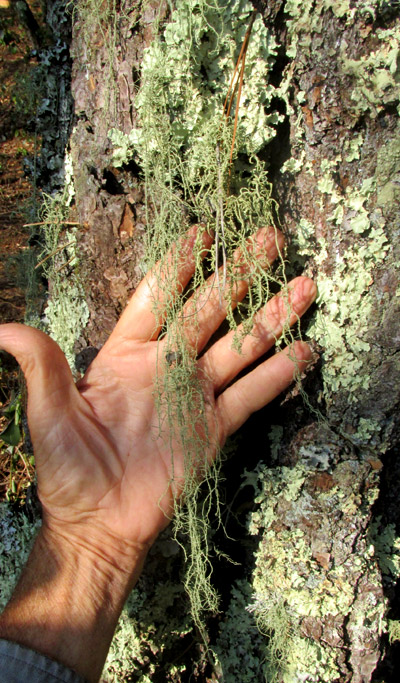Excerpts from Jim Conrad's
Naturalist Newsletter
entry from field notes dated May 7, 2023, atop hill forested with pines and oaks about 1km east of Curva de la Doctorcilla, on unnamed road connecting Hwy120 and El Doctor; limestone bedrock; elevation ±2650m (8700 ft); Eastern Sierra Madre mountains of east-central Querétaro state, MÉXICO, (N20.88°, W99.62°)
WARTY BEARD LICHEN
 Atop a hill forested with pines and oaks, the stringy lichen at the right dangled from just one pine's bark, though on this single tree several populations had established themselves. Such fruticose lichens with much-branched, slender thalli often are called beard lichens, or old man's beard. Those names are sometimes applied to species in various lichen genera, but most stringy, pale grayish-green lichens like this one belong to the genus Usnea. Currently embracing about 376 species, Usnea occurs worldwide and is commonly encountered. Here's a closer look at this one's thalli:
Atop a hill forested with pines and oaks, the stringy lichen at the right dangled from just one pine's bark, though on this single tree several populations had established themselves. Such fruticose lichens with much-branched, slender thalli often are called beard lichens, or old man's beard. Those names are sometimes applied to species in various lichen genera, but most stringy, pale grayish-green lichens like this one belong to the genus Usnea. Currently embracing about 376 species, Usnea occurs worldwide and is commonly encountered. Here's a closer look at this one's thalli:

For identification, one always hopes for well developed apothecia, which are the lichen's often distinctive looking, bowl shaped, spore producing fruiting bodies. However, no apothecia were seen on any of these populations, and that fact alone is a fairly good field mark. Often Usnea species produce apothecia readily. The above picture also shows the important feature that the main thalli's secondary branches jut outward at right angles, then gradually bend, often downward.

The above picture shows what's probably the best field mark for this species: the thalli's prolific wartiness. The warts are tuberculate outgrowths which as they wear away may turn white at their summits, then burst to form ulcer-like soralia, which contain soredia. Soredia are powdery structures composed of minute clusters of fungal hyphae surrounding algal cells. When soredia break from their thallus, if they land in the proper environment, they can grow into a new lichen. This profuse production of asexual propagules may explain why our pine tree bore several colonies of this lichen species. For many lichens, this asexual process is their main manner of reproduction.
Numerous Usnea species occur worldwide, since spores of both the lichen's fungal component and the algal part can travel great distances on wind. Several Usnea species have been documented in our general area, though none very commonly. Fortunately, there's the 1998 doctoral dissertation by María de los Ángeles Herrera Campos entitled "Revisión Sistemática del Género Usnea Hill 1753 en México." With the help of that fine work, my best bet is that our beard lichen is USNEA cf. CERATINA, often known as the Warty Beard Lichen. The "cf." is standard practice meaning I wish someone could confirm this, or suggest another species.
The main features leading to Usnea ceratina are its long-dangling nature, its thalli's abundance of "warts," its habitat preference, its known distribution, and the comments by Herrera Campos that this is one of the most commonly encountered Usnea species in Mexico. As such, and not confirming with chemical tests, the identification can only be regarded as a best educated guess. Usnea filipendula is somewhat similar, but usually that species develops a blackish trunk, while ours doesn't, its thallus branches typically are arranged opposite one another in a fishbone pattern, which ours are not, plus that species occurs less frequently in Mexico.
I can't find specific mention of our Usnea ceratina being used medicinally, but in many cultures Usnea species in general have long been used in traditional cures. Healthline.Com's Usnea page tells us that various species, which herbalists usually conflate into the name usnea, have been used traditionally since the time of Hippocrates. They add that "...Nowadays, usnea is commonly used to aid weight loss, soothe sore throats, accelerate wound healing, and reduce pain and fever," with some people suggesting it may help fight certain types of cancer.
On the other hand, Healthline.Com also reports that when taken by mouth, usnea's main active compound, usnic acid, has been linked to several cases of liver failure and death. At the least, usnea shouldn't be used in large amounts.
Usnea species also are recognized as important bioindicators; even in what seems ideal habitats for them, the more air pollution there is, the fewer Usnea lichens will be present. In places with bad air pollution, Usnea may completely disappear.